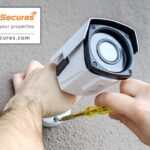To achieve professional results from your CCTV installation, follow these steps to ensure optimal coverage, image quality, and system performance:
1. Plan Your Coverage Areas
- Identify key locations: Choose areas that are critical for monitoring, such as entry points, driveways, hallways, and high-value asset zones.
- Avoid blind spots: Carefully assess each location to ensure there are no blind spots where potential incidents may go unnoticed.
- Consider lighting conditions: Install cameras in areas with adequate lighting or use infrared (IR) cameras for low-light environments.
2. Choose the Right Cameras
- Indoor vs. Outdoor cameras: Select cameras suited for their environment. Outdoor cameras should be weatherproof and durable, while indoor cameras should offer good image quality without needing additional protection.
- Resolution and quality: Opt for high-resolution cameras (1080p or higher) for clear, detailed footage. For wider areas, consider cameras with higher megapixels or adjustable lenses.
- Lens type and field of view: Choose between fixed, Varifocal, or PTZ (pan, tilt, zoom) cameras based on the specific coverage you need.
3. Optimal Camera Placement
- Mount cameras at the right height: Typically, cameras should be mounted 8-10 feet high for optimal coverage and to prevent tampering.
- Angle cameras strategically: Position cameras so that they cover large areas without obstructions. Avoid pointing cameras directly at light sources, as this can cause glare or overexposure.
- Secure mounting: Ensure cameras are securely fastened to prevent vibration or movement, which can degrade image quality.
4. Ensure Proper Wiring and Connectivity
- Use quality cables: For wired installations, use high-quality cables (e.g., Cat5e or Cat6 for IP cameras) to avoid interference and maintain a stable connection.
- Conceal wiring: Whenever possible, conceal wiring within walls or ceilings to prevent tampering and create a cleaner look.
- Check power sources: Ensure all cameras are adequately powered, whether through a PoE (Power over Ethernet) switch or a dedicated power supply for analog cameras.
5. Set Up a Reliable Storage and Recording System
- Choose the right DVR/NVR: Based on your camera type (analog or IP), select a digital video recorder (DVR) or network video recorder (NVR) that can handle the required number of channels.
- Sufficient storage: Estimate the storage you need by considering the number of cameras, resolution, frame rate, and desired retention period. Use high-capacity hard drives to avoid running out of storage.
- Cloud vs. local storage: For additional security, consider cloud storage solutions alongside local storage to ensure footage is not lost in case of damage or theft.
6. Optimize Settings for Image Quality
- Adjust camera settings: Fine-tune brightness, contrast, and sharpness to ensure clear images.
- Set motion detection zones: Configure motion detection areas to reduce false alarms and unnecessary recording.
- Frame rate and resolution: Adjust these based on your bandwidth and storage needs. Higher frame rates capture smoother motion but require more storage.
7. Test Your System Thoroughly
- Review camera views: After installation, review footage from all cameras to ensure they are capturing the intended areas.
- Check for interference: Ensure there is no interference from other electronics, Wi-Fi devices, or physical obstructions.
- Run day and night tests: Test your cameras in different lighting conditions to make sure they perform well both during the day and night.
8. Maintain Your CCTV System Regularly
- Clean lenses: Periodically clean camera lenses to avoid dust and dirt buildup, which can reduce image clarity.
- Inspect connections: Regularly inspect wiring, power supplies, and other equipment to ensure everything is functioning properly.
- Update firmware: Keep your camera software and NVR/DVR firmware up to date for optimal performance and security.

